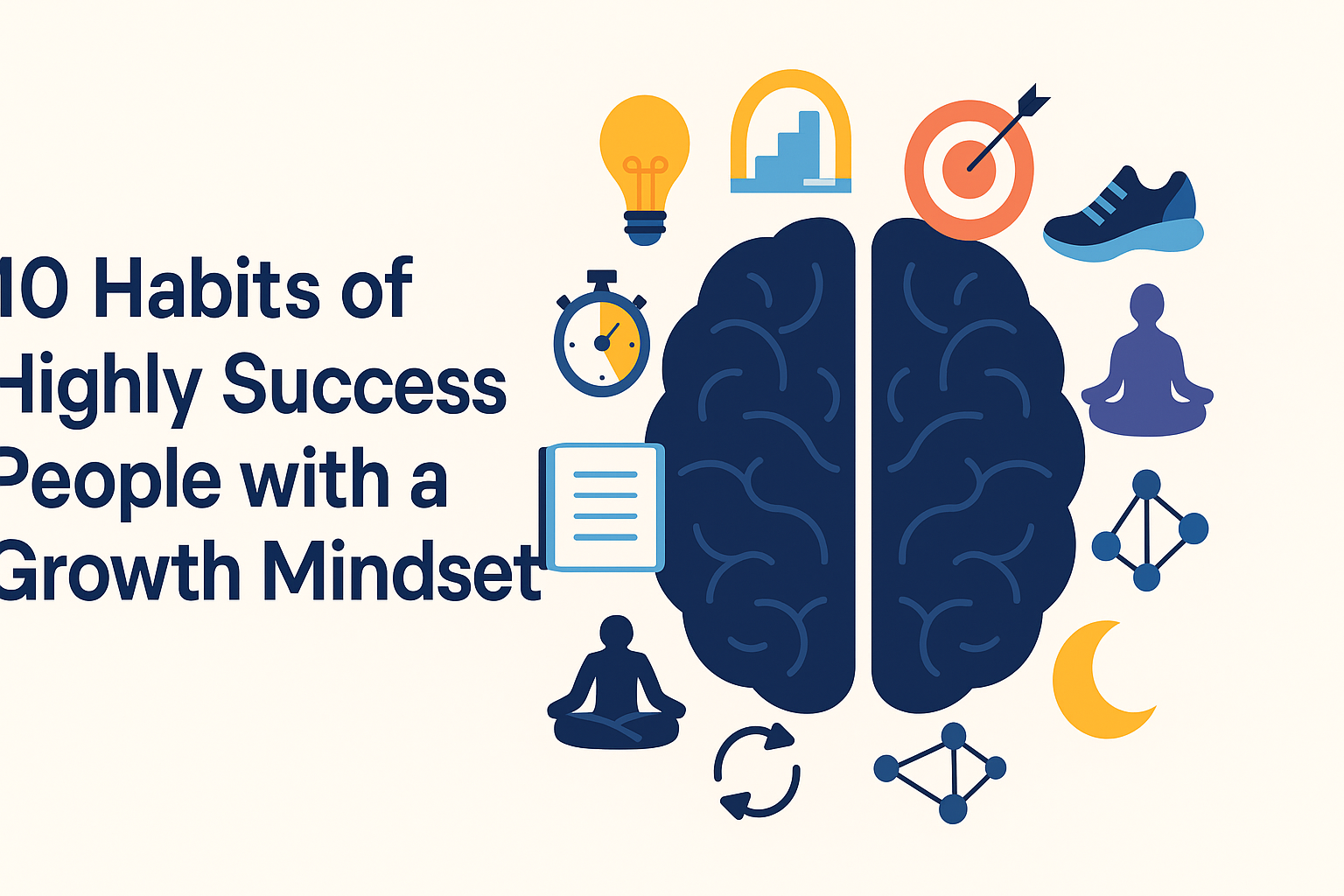If you’re serious about personal growth, the fastest way to level up isn’t to “work harder”—it’s to learn smarter. The five learning strategies below are grounded in decades of cognitive science and real-world practice. Use them together and you’ll remember more, make progress faster, and keep your momentum when life gets busy. In the first 100 words: this guide shows you exactly how to implement the top 5 learning strategies for personal growth—retrieval practice, spaced repetition, interleaving, deliberate practice with feedback, and metacognitive reflection—so you can build skills that stick and translate them into meaningful change.
Key takeaways
- Practice remembering, not just re-reading. Retrieval strengthens memory more than passive review.
- Space your study. Short sessions over time beat marathon cramming for long-term retention.
- Mix related skills. Interleaving topics sharpens judgment and transfer.
- Practice deliberately with feedback. Target specific weaknesses and measure improvement.
- Reflect and self-explain. Metacognitive routines (plan → do → review) turn effort into durable growth.
1) Retrieval Practice: Make Memory a Workout
What it is and why it works
Retrieval practice means attempting to recall information or perform a skill without looking at the answer first. When you pull knowledge out of memory—through a quiz, a blank page, or a quick teach-back—you strengthen the pathways that make future recall faster and more reliable. It’s one of the most consistently effective ways to boost long-term retention and transfer to new situations.
Core benefits
- Converts passive familiarity into usable knowledge.
- Reveals gaps you can fix (immediate feedback loop).
- Builds confidence under pressure because you practice the very act of recalling.
Requirements and low-cost alternatives
Nice-to-have: Flashcard app (e.g., any spaced-repetition tool), question banks, practice tests, audio recorder.
Low-cost: Index cards and a pen; a notebook divided into “Questions” and “Answers”.
Step-by-step (beginner friendly)
- Generate questions before you reread. After a study session, write 5–10 questions: “Explain X in your own words,” “Why does Y happen?” “Give an example of Z.”
- Close the book and answer. Set a timer for 10–15 minutes. Answer from memory—out loud or in writing.
- Check and correct. Compare to the source. Mark misses or partial answers.
- Repeat with variation. Next round, change the question form (definition → example; concept → scenario).
- Track accuracy. Log % correct and the questions you routinely miss.
Beginner modifications and progressions
- If you’re new: Start with open prompts (“Tell the story of…”).
- Progression: Move to cued recall (keywords only), then free recall (blank page).
- Advanced: Practice under constraints (explain a concept in 90 seconds, from a single diagram, or to a 10-year-old).
Recommended frequency, duration, and metrics
- Frequency: 3–5 short sessions/week (10–20 minutes each).
- Metrics: % correct on first try, time-to-recall (how long before the answer “pops”), and durability (what you still recall after 1 week).
Safety, caveats, and common mistakes
- Don’t over-test without feedback. Always verify and correct; otherwise you rehearse errors.
- Don’t only memorize definitions. Include “why,” “how,” and “apply-to-a-new-case” questions.
Sample mini-plan
- Step 1: Create 15 questions from today’s reading.
- Step 2: Tomorrow morning, answer from memory in 12 minutes; mark errors to revisit.
2) Spaced Repetition: Timing Is a Skill
What it is and why it works
Spaced repetition spreads your practice over time with increasing intervals between reviews. Instead of cramming, you strategically revisit material just as it begins to fade. This “desirable difficulty” makes the brain reconsolidate knowledge, producing durable retention.
Core benefits
- Achieves more with less total study time.
- Reduces forgetting curves dramatically.
- Keeps old knowledge alive while you add new layers.
Requirements and low-cost alternatives
Nice-to-have: A spaced-repetition app that schedules prompts automatically.
Low-cost: Calendar or habit tracker; a simple schedule like 1 day → 3 days → 7 days → 14 days → 30 days.
Step-by-step (beginner friendly)
- Choose your seed set. 20–40 cards (concepts, problems, or prompts).
- Review daily, briefly. 10–15 minutes max; stop when you hit your time cap.
- Rate difficulty. Easy → push the next review farther; Hard → bring it closer.
- Refine prompts. Convert vague items into clear cues that nudge the right answer.
Beginner modifications and progressions
- If overwhelmed: Limit to 15 items/day for the first week.
- Progression: Add application cards (new scenarios) and synthesis cards (compare/contrast concepts).
- Advanced: Stack with interleaving (see Strategy 3): mix topics in each session.
Recommended frequency, duration, and metrics
- Frequency: Daily micro-sessions (5–20 min).
- Metrics: Review completion rate, retention (% correct on first attempt), and backlog size (keep it manageable).
Safety, caveats, and common mistakes
- Don’t aim for perfection on day 1. Spacing works because you forget a bit.
- Don’t let the queue explode. Cap new items; prune or merge duplicates.
Sample mini-plan
- Step 1: Enter 25 core ideas as prompts tonight.
- Step 2: Review tomorrow morning for 12 minutes; schedule next reviews automatically.
3) Interleaving and Varied Practice: Train Your Judgment
What it is and why it works
Interleaving means mixing related topics or problem types in a single session (A–B–C–A–B–C) instead of blocking by topic (A–A–A, then B–B–B). The mix forces you to choose the right method, not just execute the one you were primed to use. In skills from art appreciation to math, languages, and sports, interleaving often improves discrimination (spotting what’s different) and transfer (applying knowledge to new cases).
Core benefits
- Builds flexible pattern recognition.
- Prevents “autopilot”—you must select a strategy each time.
- Exposes weak links that blocked practice can hide.
Requirements and low-cost alternatives
Nice-to-have: A practice bank tagged by concept/type.
Low-cost: Shuffle problems or prompts manually; rotate topics every 10 minutes.
Step-by-step (beginner friendly)
- Pick 3–4 related subskills. Example (languages): listening, vocabulary-in-context, grammar transformation, short speaking prompts.
- Create mixed sets. 2 items from each subskill per cycle.
- Alternate cycles. Repeat 2–3 cycles per session (20–30 minutes total).
- Review errors. Note which subskill drives most mistakes; target it next session.
Beginner modifications and progressions
- If brand-new: Start with short blocked warm-ups (3–5 reps) before mixing.
- Progression: Increase similarity between items so you must discriminate finer differences.
- Advanced: Mix modalities (text → diagram → audio) to deepen abstraction.
Recommended frequency, duration, and metrics
- Frequency: 2–3 sessions/week (20–40 minutes).
- Metrics: Accuracy across mixed sets, decision time (how quickly you choose a method), and error type (selection vs. execution).
Safety, caveats, and common mistakes
- Expect to feel worse short-term. Mixed practice often feels harder even while it improves long-term results.
- Don’t mix the unrelated. Interleave within a domain (e.g., algebra problem types), not random topics.
Sample mini-plan
- Step 1: For your next study block, prepare 12 prompts: 3 each from four subskills.
- Step 2: Cycle through A–B–C–D three times; log which subskill you mis-identified.
4) Deliberate Practice with Feedback: Get Better on Purpose
What it is and why it works
Deliberate practice is focused, purposeful training aimed at specific performance goals with immediate, informative feedback. Unlike “just doing it,” deliberate practice isolates bottlenecks, designs drills to address them, and measures progress over time. It drives improvement in complex skills—writing, coding, public speaking, design, analysis—where nuance and feedback matter.
Core benefits
- Turns “time spent” into targeted gains.
- Builds mental representations (seeing what experts see).
- Avoids plateaus by constantly nudging the edge of your ability.
Requirements and low-cost alternatives
Nice-to-have: Mentor/coach or peer reviewer; instrumented tasks (rubrics, checklists, version history).
Low-cost: Self-review with checklists; screen/audio recording; swap feedback with a study buddy.
Step-by-step (beginner friendly)
- Define the standard. Pick a concrete benchmark (e.g., “Deliver a 3-minute talk with <3 fillers, clear structure, one story”).
- Diagnose your gap. Record yourself; mark issues. Choose one weakness.
- Design a drill. If your issue is rambling, drill “headline first” speaking: every prompt starts with the main point in 10 seconds.
- Practice with feedback. 5–10 short reps; immediate notes; keep best take.
- Retest. Run the benchmark again; compare objectively to step 1.
- Iterate. Move to the next bottleneck.
Beginner modifications and progressions
- If you lack a coach: Use community examples or public rubrics; emulate and then deviate.
- Progression: Chain drills (e.g., clarity → pacing → storytelling).
- Advanced: Introduce constraints (time limits, noisy environment, random prompts) to stress-proof the skill.
Recommended frequency, duration, and metrics
- Frequency: 2–4 focused sessions/week, 25–45 minutes each.
- Metrics: A small set tied to your benchmark (e.g., filler word count, code review defects/hour, reading speed with comprehension).
Safety, caveats, and common mistakes
- Don’t mistake reps for progress. Deliberate practice is not rote repetition.
- Feedback must be specific. “Do better” isn’t feedback; “Your intro buries the lead—start with the result” is.
Sample mini-plan
- Step 1: This week, define a 3-metric speaking benchmark; record a baseline.
- Step 2: Run a 10-rep “headline first” drill on three prompts; retest and compare.
5) Metacognitive Reflection & Self-Explanation: Learn How You Learn
What it is and why it works
Metacognition is thinking about your thinking. Practically, that means planning what to study and why, monitoring understanding in the moment, and reviewing what worked. A simple technique inside this umbrella is self-explanation: explaining, in your own words, how a concept or solution works. Both habits accelerate understanding and help you fix errors early.
Core benefits
- Converts “I read it” into “I can use it.”
- Surfaces hidden misconceptions.
- Guides smarter choices about when to reread, practice, or move on.
Requirements and low-cost alternatives
Nice-to-have: Learning journal, weekly review template, audio notes.
Low-cost: A single notebook page divided into Plan → Do → Review with two prompts: “What did I aim to learn?” and “What changed?”
Step-by-step (beginner friendly)
- Plan (5 minutes). Choose one goal for the session (specific and time-boxed). List the strategies you’ll use (retrieval? spacing? drill?).
- Do (20–40 minutes). Work. Whenever you solve/learn something, self-explain briefly: “Why did this step follow?” “How would I teach it?”
- Review (5 minutes). Write: What worked? What confused me? What’s the smallest next step? Schedule your next review.
Beginner modifications and progressions
- If reflection feels awkward: Use a voice memo; keep it to 60–90 seconds.
- Progression: Add a weekly review with three numbers (see below).
- Advanced: Pair metacognition with goal setting (clear targets, feedback, deadlines) to align effort with outcomes.
Recommended frequency, duration, and metrics
- Frequency: Every study session (5–10 minutes total) + a 20-minute weekly review.
- Metrics: Track three KPIs weekly: (1) sessions completed, (2) average recall % on first attempt, (3) one insight/change you made.
Safety, caveats, and common mistakes
- Don’t turn reflection into procrastination. Keep it short and actionable.
- Beware fluency illusions. If you can’t explain it simply, you don’t own it yet.
Sample mini-plan
- Step 1: End each session with two sentences: “I can now ___ because ___.”
- Step 2: On Sunday, review your three KPIs and pick one change for next week.
Quick-Start Checklist
- Choose one project that matters (language, certification, portfolio skill).
- Add retrieval practice to your next session (5–10 questions).
- Set a spacing schedule (1–3–7–14–30 days).
- Build a 12-prompt interleaved set across 3–4 subskills.
- Define a deliberate practice benchmark with 2–3 objective metrics.
- End every session with a 60-second self-explanation and next action.
Troubleshooting & Common Pitfalls
- “I forget too much between sessions.” That’s normal—and helpful. Shorten the spacing temporarily, then lengthen again as recall improves.
- “Mixed practice confuses me.” Start with a brief blocked warm-up before you interleave.
- “I’m doing reps but not improving.” You’re probably repeating, not practicing deliberately. Narrow the target (one metric), add immediate feedback, and retest.
- “Reviews eat my time.” Cap daily reviews (e.g., 15 minutes). Add fewer new items. Merge duplicates.
- “I feel like I understand while reading, but blank on recall.” Replace rereading with retrieval prompts and self-explanations.
- “I can’t find a coach.” Use peer swaps, public rubrics, and exemplars; ask for one specific critique.
- “I lose motivation.” Tie sessions to a visible scoreboard (three KPIs) and celebrate streaks, not hours.
How to Measure Progress That Actually Matters
Track outputs you control and outcomes you want:
Weekly scoreboard (keep it simple):
- Inputs: Sessions completed; minutes of deliberate practice; number of retrieval prompts answered.
- Process quality: % first-try correct; average difficulty rating (“easy/medium/hard”); # of self-explanations logged.
- Outcomes: One tangible artifact (a page of notes, a solved problem set, a 3-minute talk, a mini-project).
Monthly pulse checks:
- Baseline vs. current on your benchmark metrics (e.g., reading speed with comprehension; defect rate in code reviews; pronunciation accuracy from recordings).
- Transfer test: apply the skill in a new context (new dataset, unfamiliar text, different audience).
A Simple 4-Week Starter Plan
Week 1 — Build the engine
- Focus: Retrieval + Spacing.
- Actions: Create 30 prompts from your core material. Do 5 × 15-minute sessions. Start the 1–3–7–14 schedule.
- Deliberate drill: Identify one bottleneck; design a 10-rep micro-drill.
- Reflection: End each session with a 60-second self-explanation.
- Goal: Hit 5 sessions; log % first-try correct.
Week 2 — Mix and tighten
- Focus: Interleaving.
- Actions: Build a 12-item mixed set across 3–4 subskills; run it twice this week.
- Deliberate drill: New 10-rep drill on your top weakness.
- Spacing: Keep daily micro-reviews (cap 15 minutes).
- Reflection: Add a 15-minute weekly review on Sunday (what to change).
- Goal: Improve first-try recall by 10% vs. Week 1 (or reduce decision time).
Week 3 — Raise the bar
- Focus: Deliberate practice with clearer metrics.
- Actions: Define a three-metric benchmark for your skill; record a baseline attempt on Monday and a retest on Friday.
- Interleaving: Increase item similarity; force finer discrimination.
- Reflection: Capture one insight per day; schedule a specific next step.
- Goal: Measurable improvement on at least one benchmark metric.
Week 4 — Stress-proof and transfer
- Focus: Performance under constraints.
- Actions: Add time limits, noise, or an unfamiliar context. Teach a concept to someone else or publish a mini-artifact.
- Spacing: Keep reviews short; prune items you truly know.
- Reflection: Monthly pulse check—compare to Week 1 baseline.
- Goal: Demonstrate transfer: apply your skill to a fresh, slightly different task.
FAQs
1) Do I have to use an app for spaced repetition?
No. A calendar or simple checklist works. Apps help automate scheduling, but the principle—review just as you’re starting to forget—is what matters.
2) How many retrieval questions should I do per session?
10–20 is plenty for most topics in 10–20 minutes. Stop when quality drops; schedule the next review.
3) Interleaving makes me feel slower. Is that bad?
Short-term “slowness” is normal. Interleaving trains selection and discrimination, which pay dividends on real tasks and exams.
4) What’s the difference between repetition and deliberate practice?
Repetition counts reps; deliberate practice targets a specific weakness, uses immediate feedback, and retests against a clear standard.
5) How do I self-explain without rambling?
Use a micro-template: Claim → Because → Example. Keep it to 60–90 seconds or 3–5 sentences.
6) How often should I reflect?
Briefly after every session (1–2 minutes) and once weekly (15–20 minutes) to adjust your plan.
7) Can I combine all five strategies in one session?
Yes. Example: Start with a retrieval warm-up, run an interleaved set, finish with a deliberate drill, then write a 60-second self-explanation and schedule spaced reviews.
8) What if I’m studying multiple subjects?
Assign each subject 2–3 short blocks per week. Keep a shared KPI scoreboard. Interleave within each subject; avoid chaotic cross-mixing.
9) How do I pick good metrics?
Choose 2–3 that reflect performance, not just time: accuracy on first attempt, speed with quality, error rate, or a mini-artifact produced.
10) How do I stay motivated long-term?
Shrink the unit of progress. Track streaks, publish small artifacts, and meet a peer monthly to share one insight and one challenge.
11) Is rereading ever useful?
Yes—for orientation or to clarify after a failed retrieval attempt. But as a primary strategy, rereading is less effective than retrieval + spacing.
12) How soon should I see results?
You’ll often notice better recall within 1–2 weeks of consistent retrieval and spacing, and clearer performance gains within 3–4 weeks of deliberate practice.
Conclusion
Personal growth accelerates when your process improves. Practice remembering (retrieval), time your reviews (spacing), mix what you practice (interleaving), target weaknesses with feedback (deliberate practice), and close the loop (metacognition and self-explanation). Treat each session as a small bet on future you—and keep score in ways that reward consistency and real progress.
CTA: Pick one strategy above and use it in your very next 20-minute session—then schedule the follow-up before you close your notebook.
References
- Improving Students’ Learning With Effective Learning Techniques: Promising Directions From Cognitive and Educational Psychology, Psychological Science in the Public Interest (PDF hosted at gwern.net), 2013. https://gwern.net/doc/psychology/spaced-repetition/2013-dunlosky.pdf
- Test-Enhanced Learning: Taking Memory Tests Improves Long-Term Retention, Psychological Science, 2006 (PDF mirror). https://colinallen.dnsalias.org/Readings/2006_Roediger_Karpicke_PsychSci.pdf
- Spacing Effects in Learning: A Temporal Ridgeline of Optimal Retention, Psychological Science (PDF, UCSD), 2008. https://laplab.ucsd.edu/articles/Cepeda%20et%20al%202008_psychsci.pdf
- Learning Concepts and Categories: Is Spacing the “Enemy of Induction”?, Psychological Science (PDF), 2008. https://sites.williams.edu/nk2/files/2011/08/Kornell.Bjork_.2008a.pdf
- Why Interleaving Enhances Inductive Learning: The Roles of Discrimination and Retrieval, Psychonomic Bulletin & Review (preprint PDF), 2012. https://teacherhead.com/wp-content/uploads/2014/09/birnbaum_kornell_ebjork_rbjork_inpress.pdf
- The Testing Effect Is Alive and Well With Complex Materials, Educational Psychology Review (PDF, Purdue Learning Lab), 2015. https://learninglab.psych.purdue.edu/downloads/2015/2015_Karpicke_Aue_EDPR.pdf





































